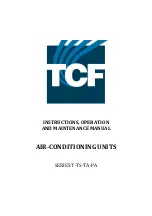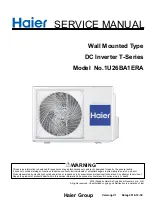
10 Troubleshooting
Installer reference guide
24
2(A)MXM40+50M(3)(4)V1B(9)_2(A)MXF40+50A2V1B
R32 Split series
4P600463-2 – 2019.10
DANGER: RISK OF ELECTROCUTION
▪ Use this compressor on a grounded system only.
▪ Turn the power off before servicing the compressor.
▪ Reattach the switch box cover and service lid after
servicing.
CAUTION
Always wear safety goggles and protective gloves.
DANGER: RISK OF EXPLOSION
▪ Use a pipe cutter to remove the compressor.
▪ Do NOT use the brazing torch.
▪ Use approved refrigerants and lubricants only.
DANGER: RISK OF BURNING
Do NOT touch the compressor with bare hands.
10
Troubleshooting
10.1
Overview: Troubleshooting
This chapter describes what you have to do in case of problems.
It contains information about solving problems based on symptoms.
Before troubleshooting
Carry out a thorough visual inspection of the unit and look for
obvious defects such as loose connections or defective wiring.
10.2
Precautions when troubleshooting
WARNING
▪ When carrying out an inspection on the switch box of
the unit, ALWAYS make sure that the unit is
disconnected from the mains. Turn off the respective
circuit breaker.
▪ When a safety device was activated, stop the unit and
find out why the safety device was activated before
resetting it. NEVER shunt safety devices or change
their values to a value other than the factory default
setting. If you are unable to find the cause of the
problem, call your dealer.
DANGER: RISK OF ELECTROCUTION
WARNING
Prevent hazards due to inadvertent resetting of the thermal
cut-out: power to this appliance MUST NOT be supplied
through an external switching device, such as a timer, or
connected to a circuit that is regularly turned ON and OFF
by the utility.
DANGER: RISK OF BURNING
10.3
Solving problems based on
symptoms
10.3.1
Symptom: Indoor units fall, vibrate or
make noise
Possible causes
Corrective action
The indoor units are not installed
securely
Install the indoor units securely.
10.3.2
Symptom: The unit is NOT heating or
cooling as expected
Possible causes
Corrective action
Wrong connection of the
electrical wires
Connect the electrical wires
correctly.
Gas leakage
Check for gas leakage.
Marks on the wiring and piping
do NOT match
Marks on the wiring and piping
(room A, room B, room C, room
D, room E) for each indoor unit
MUST match.
10.3.3
Symptom: Water leakage
Possible causes
Corrective action
Incomplete thermal insulation
(gas and liquid piping, indoor
portions of the drain hose
extension)
Make sure the thermal insulation
of the piping and the drain hose
is complete.
Improperly connected drainage
Secure the drainage.
10.3.4
Symptom: Electrical leakage
Possible causes
Corrective action
The unit is NOT earthed correctly Check and correct the
connection of the earth wiring.
10.3.5
Symptom: Unit does NOT function or burn
damage
Possible causes
Corrective action
The wiring was NOT performed
in accordance with the
specifications
Correct the wiring.
11
Disposal
NOTICE
Do NOT try to dismantle the system yourself: dismantling
of the system, treatment of the refrigerant, oil and other
parts MUST comply with applicable legislation. Units
MUST be treated at a specialised treatment facility for
reuse, recycling and recovery.
11.1
Overview: Disposal
Typical workflow
Disposing of the system typically consists of the following stages:
1
Pumping down the system.
2
Bringing the system to a specialized treatment facility.
INFORMATION
For more details, see the service manual.





































